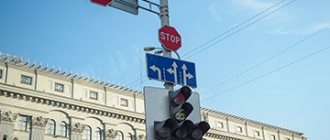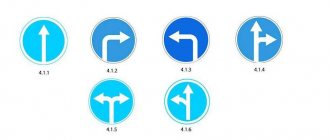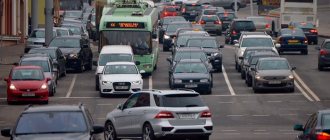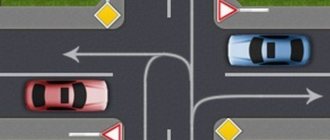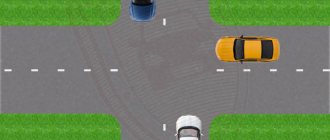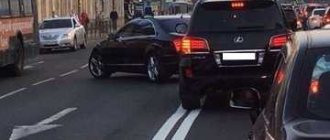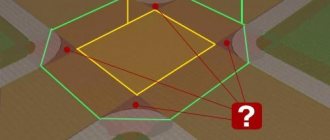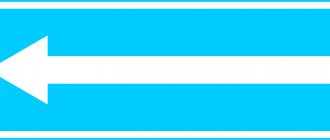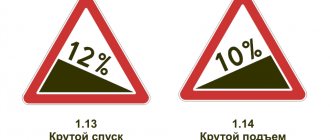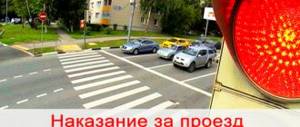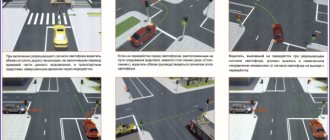Turn right - enter the adjacent territory or yard
Sometimes it happens that another car is parked in front of the entrance. He may be standing in violation of traffic rules or without a violation, it doesn’t matter, but he is standing exactly in front of the entrance where you need to turn.
In general cases, when turning right from the right lane is free, the driver’s sequence of actions is usually as follows: When moving in the far right lane, it is necessary to turn on the right turn indicator in advance, reduce the speed and turn right, taking into account paragraph 13.1 of the traffic rules (if necessary).
When the entrance and exit are narrow, and at that moment another car is leaving the territory, it is advisable to first let him out, then drive in yourself.
But when there is a parked car in front of the entrance or entry from the right lane is difficult for some reason, then in order to turn right, you will first have to go around this “obstacle” from its left side. To do this, you need to follow all the rules to move to the left.
left indicator must first be turned on , followed by changing lanes from the right to the left lane and turning off the turn signal. Next, a smooth decrease in speed, after reaching the “obstacle”, you need to immediately turn on the right “turn signal” and, having completed the detour, turn right, into the territory or into the yard, in general, where you need to go.
The described algorithm is fraught with three dangerous points. First, the left door of a stationary car may suddenly open, so when driving around it, you should not press close to it.
But you shouldn’t move too far away from it either, otherwise the driver behind you may misinterpret your maneuver and try to “wedge itself” between your car and the parked car. This is precisely where the second danger lies. Instead of a car, a motorcyclist can ride behind, and in order to pass between cars, he needs very little space.
You should not linger in the left lane for long - as soon as the detour is completed, you must immediately go to the right.
And the third dangerous point is that a stationary car can start moving, and without any direction indicators.
You should try to foresee such a possibility based on indirect signs: whether there is a driver in the car, whether the engine is running (can be determined by the exhaust, but in the summer, for example, this is difficult), the moment it begins to move (from the side you can determine by the start of rotation of the wheels).
If you have doubts that a parked car will let you pass ahead, when approaching, you can briefly sound the horn to warn of a possible collision.
Penalty for turning left
Notice the orange car in the picture. He is trying to turn left from the straight ahead lane (sign 5.15.2).
In this case, the violator will be punished under Part 2 of Article 12.16 of the Code of Administrative Offenses:
2. Turning left or making a U-turn in violation of the requirements prescribed by road signs or markings of the roadway -
shall entail the imposition of an administrative fine in the amount of one thousand to one thousand five hundred rubles.
The fine for turning left from the wrong lane will be 1,000 - 1,500 rubles .
Punishment may be imposed in the following cases:
| At the intersection there are signs 5.15.1 or 5.15.2 indicating the permitted directions along the lanes. |
| There is a 1.18 marking at the intersection, which shows the directions for each lane. |
If there are no signs or markings at the intersection, then the driver can be punished under Article 12.14 of the Code of Administrative Offenses, but this will be discussed below.
Turn right at an intersection
Dangerous situations when turning right at a regular, non-roundabout intersection.
When turning right, in accordance with paragraph 13.1 of the traffic rules, the driver is obliged to give way to pedestrians crossing the roadway on which the turn is being made, and to cyclists traveling through this roadway on a bicycle path (if there is one). Drivers have no questions with these road users.
Problems arise when the right side of the roadway into which the turn is being made is, for various reasons, crowded with other vehicles. For example, there may be a public transport stop there, and during rush hours the entire right lane immediately after the intersection will be occupied.
You will have to somehow get around this traffic jam, but then the turn to the right will be made not into the right lane, as paragraph 8.6 of the traffic rules indicates, but into the one that is located to the left. And at this moment you need to pay attention to the situation to the left and left-behind of you.
The fact is that often, especially during rush hours, there are many people who want to turn right from the left lane. They, without ceremony, rush forward and turn sharply, cutting off the path of those who turn from the right lane.
Such an action is a violation and the reasons in this case are not important, but it does occur. When the violator is “caught”, he will most likely be fined, let those who are supposed to do this, but now the task is different - to avoid an accident.
Therefore, when turning right at an intersection, it makes sense to pay attention to the situation to the left and to the left behind you.
Another thing you need to pay attention to is this. If a traffic light at an intersection is equipped with an additional section for turning right, then depending on the combination of signals of this traffic light, the priority in relation to oncoming traffic will change. This feature must be taken into account. Details of this situation are in the article Turn right and paragraph 8.6 of the traffic rules.
The situation is somewhat different when on multi-lane roads a right turn is allowed from the second lane. In such cases, when turning right from the second lane, you need to carefully monitor the situation on the right and right-behind of your car. There is always a risk that someone will “come” from there.
One such case was discussed in detail in the article Risky turn at a wide intersection, and a slightly different case - entering the adjacent territory in a permitted case from the second lane - in the article of the same name Turning right from the second lane.
In what cases is it permissible to turn out of your lane?
In a real situation on the road, anything can happen. The driver does not face a fine for turning out of line if there are circumstances provided for in Section 8 of the Traffic Regulations, paragraphs. 8.3; 8.7; 8.8:
- If the vehicle has dimensions that do not allow maneuvering from the extreme side of the intended turning lane, or there are other reasons, it is allowed to deviate from the requirements of clause 8.6, while ensuring conditions for the safe movement of cars and people in the same and oncoming directions (8.7).
- In the case of making a U-turn on a section of the road that is not prohibited for such a maneuver and is not wide enough, it is allowed to drive onto the right lane or shoulder (8.8), but when leaving, take into account the requirements of clause 8.3 about taking up space on the roadway from the adjacent territory and not creating interference for other participants movements.
When making turns from the second row, a fine is provided, as well as for any maneuvering within pedestrian crossings and tunnels marked with signs or markings, on (under) overpasses, bridges, railway crossings, drop-off and pick-up points for public transport passengers, as well as limited visibility within a hundred meters on both sides.
Rules for crossing signalized intersections
When approaching the intersection of two or more roads, we determine the type of intersection: regulated or unregulated. The order of our subsequent actions on the road depends on this. A regulated intersection is one where there is a traffic light or where a traffic police officer works as a traffic controller. For such intersections, the traffic rules have rules for their passage:
- The working three-color traffic light cancels the existing "Main Road" and "Give Way" signs.
- You can only move when there is a green (permissive) signal. Observe the lane when driving, and occupy the appropriate lane in advance.
- When the traffic light turns on, you must give way to all vehicles and pedestrians completing their maneuver at the intersection.
- At a traffic light with an additional section with an arrow, movement is allowed only in the direction indicated by the arrow and when it is turned on.
- The green arrow turns on simultaneously with the red signal. This means that travel in this direction is allowed, but you will need to give way to all vehicles moving in other directions.
- The actions of the traffic controller have the highest priority, even if they contradict road markings and traffic lights.
We invite you to read: Replacement of rights after expiration of the term in the Moscow region
At first, novice drivers are afraid of busy intersections and turning left there. There are several reasons for this.
Turn left - trajectory
Firstly, during such a maneuver you have to be especially careful and let not only oncoming traffic pass, but also pedestrians. The speed of oncoming traffic can be high, which creates nervousness for beginners while waiting for a “window” to maneuver.
Secondly, when turning left, the car's stance impairs visibility and you have to additionally turn your head to safely complete the maneuver.
Thirdly, you often have to complete the maneuver while the green light is flashing and drive through the intersection together with cross-direction vehicles that have already started moving. This situation is eliminated if the traffic light has an additional side section with an arrow.
Recommendations for beginners that will help them feel more confident at an intersection:
- If you approach a traffic light that is green, reduce your speed. Perhaps at this time a car that did not have time to pass is completing the maneuver. You need to be especially careful at intersections with limited visibility.
- If you notice a red traffic light in the distance, take your time and reduce your speed. As you approach, the light may turn green and you will pass without stopping.
- It is not recommended to jump through a signalized intersection when the green signal is flashing. The traffic light blinks for only 3 seconds, and then it turns yellow, which is prohibited. You can continue driving only if you have to use emergency braking to stop.
Lecture notes on traffic rules "Turns"
Topic 8.3. Turns.
Rules.
Section 8. Clause 8.5. Before turning right, left or making a U-turn, the driver must take the appropriate extreme position in advance on the roadway intended for traffic in this direction.
Note! – The rules do not specify where the turn is made and, therefore, this requirement applies to all cases of turns - at intersections and outside intersections, on public roads and outside roads.
And pay attention! — the Rules do not say that a right turn must be made only from the extreme right lane, and a left turn only from the extreme left lane. The rules couldn’t say that, because there are intersections where turns are allowed from several lanes. Therefore, the authors of the Rules were forced to speak out this way:
For turns, use
the appropriate extreme position on the roadway in that direction!
We just have to figure out what it is - the corresponding extreme position
- in relation to various situations.
If this is a classic four-way intersection, then everything is simple:
— the corresponding extreme position for turning right is the right lane;
— the corresponding extreme position for turning left is the left lane;
— directly possible from all lanes.
The situation will change fundamentally if signs appear at the same intersection establishing a different traffic order. For example, signs of special regulations (as in our picture) may allow a right turn from two lanes.
Then this intersection has not one, but two corresponding positions
for turning right
- if you want, turn from the right lane, if you want, turn from the middle one.
Note! — the same signs prohibit driving directly from the right lane.
Well, how could it be otherwise? Otherwise there will be constant fighting here.
As for intersections with roundabouts, there cannot be any “straight” or “left”; entering the roundabout is always a right turn. And the corresponding position for turning right is the right lane. And if this principle is maintained, all other lanes in this direction will not be used at all, and a huge queue will line up on the far right.
Therefore, for roundabout intersections, the Rules made an exception, and paragraph 8.5 in full reads like this:
Rules.
Section 8. Clause 8.5. Before turning right, left or making a U-turn, the driver is obliged to take in advance the appropriate extreme position on the roadway intended for traffic in a given direction, except when making a turn when entering an intersection where there is a roundabout .
As you can see, the requirement of paragraph 8.5 does not apply to a roundabout intersection!
Students.
That is, this is what happens! – The rules allowed you to enter the circle from any lane!?
Teacher.
At first glance, this is exactly what it looks like, and many drivers think so. But in reality this is not entirely true. In fact, the authors of the Rules wanted to say the following:
Clause 8.5
does not prohibit entering the circle from other lanes (no matter how many there are).
But the rules don't end there. In addition to clause 8.5, the Rules contain other requirements. Very soon we will study Section 9 “Location of vehicles on the roadway” and learn a lot of new things, namely:
In a populated area on a two-lane
driving in this direction, drivers are allowed to occupy any of these two lanes. Even on a completely empty road, everyone is allowed to drive in either the right or left lane.
Accordingly, if there are only two lanes in your direction, and it happens in a populated area
, you can enter the circle from any of them.
During the traffic police exam you will be asked the following problem:
From which lane is it allowed to enter this intersection? 1. Only from the right. 2. Only from the left. 3. From any. Comment on the task. The answer should not leave you in any doubt. This is happening in a populated area, there are two lanes of traffic in your direction, therefore, you can enter the circle from any lane (even on an empty road). |
Again, in a populated area, on a road
with three or more lanes in a given direction,
the Rules allow you to occupy the far left only during heavy traffic, when all the right lanes are occupied.
Accordingly, enter a roundabout on an empty road with three or more lanes
allowed from any lane except the far left.
This is if in a populated area.
And outside the populated area on any road, the Rules strictly prescribed:
Everyone should move as far to the right as possible!
That is, outside a populated area
on an empty road,
the driver must always move in the far right lane.
Accordingly, we will enter the circle on an empty road from the far right lane.
If the traffic is heavy and all the lanes are occupied, then it doesn’t matter whether it’s a populated area or not and how many lanes there are. In such a situation, it is allowed to enter the circle from all lanes.
At this point in driving school classes, students always ask the question: “Which trajectory should you take to enter the circle from the first lane, which trajectory should you take from the second lane, and which turn signals should you turn on?”
As for the direction indicators, they are right and only right! No matter what lane you enter the roundabout from, you always turn right!
As for the trajectory of a right turn, let’s turn to the Rules:
Rules.
Section 8. Clause 8.6. When turning right, the vehicle should move as close as possible to the right edge of the roadway.
In other words, when turning right, drivers are required to move as far to the right as possible! More precisely: before entering a turn, drivers are first required to take the appropriate extreme position (in accordance with paragraph 8.5), and only then, in accordance with paragraph 8.6, they must drive their vehicle as far to the right as possible.
If you approach the circle in the far right lane, then when turning into the circle, you should only enter the far right lane! In this case, this will be “as right as possible.”
If you enter the circle from the second lane, then two scenarios are possible.
If everything is free on the right, then “as far to the right as possible” there will also be an entry into the far right lane.
If the right is busy, then “as far to the right as possible” will be driving into the second lane on the circle.
In the traffic police examination book there is a problem on this topic, and here you often make mistakes due to inattention:
Which trajectory are you allowed to continue moving on? 1. Only according to A. 2. By A or B. 3. For any of the above. Comment on the task. Look carefully - there is only one lane on the road in your direction! In this case, “as far to the right as possible” is only trajectory A. |
So, when entering a circle, the Rules do not oblige drivers to take the extreme right position on the roadway.
As for leaving the circle, the Rules did not say anything special about this. And, therefore, when leaving the circle, drivers are obliged to be guided by the general principle:
Rules.
Section 8. Clause 8.5. Before turning right, left or making a U-turn, the driver must take the appropriate extreme position in advance on the roadway intended for traffic in this direction.
And they also ask about this during the exam, and they ask in a sophisticated way:
Only in circles. 2. Only to the right. 3. In any direction listed. Comment on the task. In the situation shown, the driver of a passenger car, intending to leave the circle, was obliged to change lanes to the far right lane in advance. He didn’t do this and now, in order not to break the Rules, he will have to ride in a circle again. Let us note that this requirement of the Rules (you must leave the circle from the far right lane) is absolutely logical. After all, the truck can go straight ahead, but you turn right from the second lane - and there you have an accident. True, the truck can turn right, but for the driver of the car this does not matter: Before turning right, the driver must take the appropriate extreme position! |
And another illustrative problem from the traffic police examination book on the same topic:
Are you allowed to make a right turn along the indicated trajectory in this situation? 1. Allowed. 2. Prohibited. Comment on the task. The peculiarity of this situation is that the right lane on the road being crossed is occupied by a parked car. Well, well, this happens. And the Rules in this situation in no way prohibit turning, they only still require: When turning right, you must stay as far to the right as possible! And in this situation, “as far to the right as possible” there will be a turn along the indicated trajectory. |
If we talk about turning right, then, in fact, that’s all. The Rules did not impose any other requirements for this maneuver. Well, except that to some extent the first part of paragraph 8.6 can also be attributed to turning right:
Rules.
Section 8. Clause 8.6. The turn must be made in such a way that when leaving the intersection of roadways, the vehicle does not end up in the lane of oncoming traffic.
It takes a lot of effort to get into oncoming traffic when turning right. But when turning left, drivers often commit this violation, even when completely sober.
The area of intersection of roadways is highlighted in beige in the figure, and according to the Rules, when leaving this rectangle, the driver should not find himself in the lane of oncoming traffic.
Such a violation is qualified as driving into oncoming traffic and is punishable by deprivation of rights for a period of 4 to 6 months (for the first time they may regret it - a fine of 5,000 rubles).
And there is nothing more about the left turn trajectory in the Rules! That is, if it is clearly said about turning right: “you need to stay as far to the right as possible,” then nothing is said at all about the trajectory of turning left. The only condition is not to end up in the oncoming lane.
This means that when turning left, the Rules allowed drivers to enter
to any free lane!
Here's how you'll be asked about it during the traffic police exam:
You can continue driving when turning left: 1. Only along trajectory A. 2. Only along trajectory B. 3. Along any trajectory from those indicated. Comment on the task. The third correct answer is “Any way.” Although the question for the authors of this problem still remains: “How can this be? After all, the Rules prohibit occupying the far left lane on a three-lane road when the right lane is free!” A person who knows the Rules well may be stunned by this problem! The correct answer should be “According to trajectories A or B,” but they didn’t offer it to us!? The authors of this problem simply want to find out if you know Section 8 of the Rules (without taking into account other requirements). And they expect the following answer from you: “Yes, I know that the Rules did not impose any special requirements on the left turn trajectory itself (the only requirement is not to end up in oncoming traffic).” |
And one more problem about a left turn that you should pay your attention to.
Which trajectory are you allowed to make a left turn? 1. Only according to A. 2. Only according to B. 3. For any of the above. Comment on the task. Look carefully at the drawing. The road you are driving on will only become a two-way road after the intersection. And until the intersection it is a one-way road! What is the appropriate extreme position for turning left? maybe on a one way road? So, as strange as it may seem, drivers are required to turn left in this situation from the far left lane. And this is logical - the right lane will be free for those who intend to move straight or are planning to turn right. |
A special case of turning left is turning from tram tracks.
Driving onto tram tracks in the opposite direction is strictly prohibited by the Rules (according to the Rules, this means driving into oncoming traffic), but it would be irrational not to use tram tracks in the same direction. After all, this is another lane of traffic - you can significantly increase the road capacity.
And the Rules allowed this, but subject to certain conditions:
Rules.
Section 9. Clause 9.6. Traffic is allowed on tram tracks in the same direction, located on the left at the same level as the roadway, when all lanes in this direction are occupied. In this case, there should be no interference with the tram.
In the figure, the driver of the white car is not violating anything - both lanes of this direction are occupied, the tram tracks in the same direction are located at the same level as the roadway, there are no trams and, therefore, you can move along these same tram tracks.
There is also clause 8.5 in the Rules:
Rules.
Section 8. Clause 8.5, second paragraph. If there are tram tracks of the same direction on the left at the same level as the roadway, left turns and U-turns
must be made from them. Oh how! Direct movement along the tram tracks The rules allow (but do not oblige you to do this), and drivers are required to make a left turn or a U-turn from the tram tracks!
And there is a problem about this situation in the traffic police collection:
You can make a left turn: 1. Only along trajectory A. 2. Only along trajectory B. 3. Along any trajectory from those indicated. Comment on the task.
I just want to say to the driver of the blue jeep: “To turn left, take the tram tracks (as required by the Rules), and then no one will move to the left of you”! |
But that’s not all, paragraph 8.5 has a continuation:
Rules.
Section 8. Clause 8.5, second paragraph. If there are tram tracks of the same direction on the left at the same level as the roadway, a left turn and a U-turn must be made from them, unless signs or markings prescribe a different movement order .
That is, if there are no signs (or markings) prescribing a different order of movement, we turn left from the tram tracks, and if there are signs (or markings) then we must comply with the requirements of these same signs (or markings).
And in the exam (and in life) it will look like this:
| Which trajectory are you allowed to make a left turn? 1. Only according to A. 2. Only according to B. 3. For any of the above. Comment on the task. The situation has changed - in front of the intersection there is a sign “Direction of traffic in lanes”. And also markings (arrows on the roadway). This sign and these markings dictate to drivers: No one has the right to move through the intersection on tram tracks! Left turns and U-turns are permitted |
But that's not all! Of course, the Rules had to take care that there was no interference with the movement of trams, and paragraph 8.5 in the Rules is spelled out in full as follows:
Rules.
Section 8. Clause 8.5. Before turning right, left or making a U-turn, the driver is obliged to take in advance the appropriate extreme position on the roadway intended for traffic in this direction, except in cases where a turn is made when entering an intersection where a roundabout is organized.
If there are tram tracks in the same direction on the left, located at the same level as the roadway, a left turn and a U-turn must be made from them, unless signs 5.15.1 or 5.15.2 or markings 1.18 prescribe a different movement order. In this case, there should be no interference with the tram.
And here we come to a situation that raises legitimate questions and is hotly discussed in various forums. How can you order a left turn from the tram tracks without interfering with the tram? Dear authors of the Rules, you have set an impossible task for drivers!
Let's put aside emotions and try to figure out if this is so.
The rules allowed movement along tram tracks (if all lanes in a given direction are occupied), and turning left or turning around was not just allowed, but strictly prescribed - always from the tram tracks!
So the drivers lined up on the tram tracks, waiting for the opportunity to turn left.
And then, inopportunely, the tram arrived. So what, now they are all violators, and we urgently need to change lanes onto the roadway?
No, nothing is needed, now drivers do not break the Rules. After all, what is “give way” according to the Rules - this is a requirement that means that a road user should not
start, resume or continue moving, or carry out any maneuver
, if this may force other road users who have an advantage over him to change direction of movement or speed.
That is, according to the Rules, you can create an obstacle only in dynamics, starting or continuing movement. And now the drivers don’t move at all, they stand motionless, and when they go, they don’t interfere with the tram, on the contrary, they clear the tram tracks. In the meantime, both cars and trams are simply standing in a general queue, waiting for the opportunity to continue moving in the intended direction.
Another thing is the maneuver of changing lanes onto tram tracks. This is exactly what the Rules had in mind. Here, please, when stopping on the tram tracks, give way to the tram.
That's it now!
